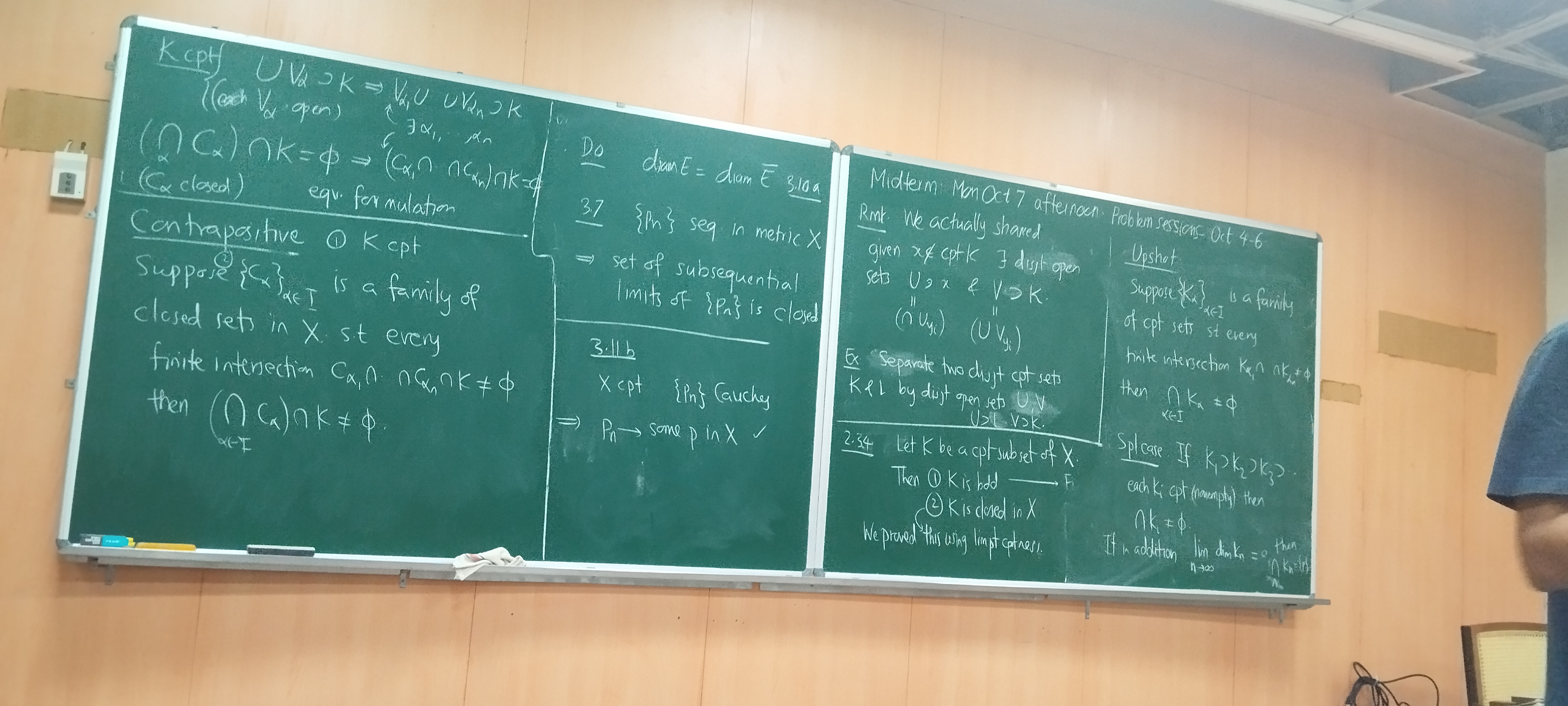
Proof of Rudin, 2.34 using open cover compactness
Alternate proof of compact sets being closed using open cover compactness (we proved boundedness using OCC in L17).
Rudin, 2.34
Theorem 1.
Let be a compact subset of . Then is closed in .
Proof
We will show is open in . Let . We have to show that a neighborhood of in is contained in . For every find disjoint open sets containing and containing . Then, . Now, observe thatRecall that finite intersections of open sets are open. Since is compact, there exists a finite subcover of , i.e, . Since is finite, is open in . So,
❏
Alternate proof (Abbot)
We have to show that every point in which is a limit point of is in . Let be a sequence in , with . FTSOC, assume . So, every is a positive distance away from . Let . Clearly, is an open cover of , and . Let be a finite subcover. Let be the minimum of the radii of the balls in this finite subcover. Since , we can find terms of the sequence inside an ball around , not covered by our supposed finite subcover. ❏
Note that we actually ended up proving a stronger result: For every , there exist disjoint open sets and , where and .
Exercise: Show that for two disjoint compact sets and , there exist disjoint open sets and such that and .
Proof
It follows from the previous theorem that for every , there exist disjoint open sets and such that and . Clearly, is an open cover of . Since is compact, there exists a finite subcover . Now, observe thatSetting and works, because
- .
- is open, since any union of open sets is open.
- is open, since a finite intersection of open sets is open and is finite.
- and .
❏
Proof of compactness of closed intervals in R using LUB property
Proof
Consider an open cover of . Define to be the set of all such that can be covered by a finite subcover of . This set is non empty because . Let . Assume . There exists a containing . Since is open, it must also contain an open interval around , say . Now, must have a finite subcover . Thus, covers . So, . This contradicts the hypothesis that is the supremum of . Hence, . ❏
Rudin, 2.36
Let , be a collection of open sets in . Then, is compact iff
Now, we will rephrase the hypothesis in terms of closed sets .
Ditto for the conclusion.
Thus, we say is compact iff, for any collection of closed sets ,
We can consider all to be compact subsets of , since compact sets are in particular closed sets. Now, say is compact. Augment such that it now contains (update accordingly). This gives us
Take the contrapositive of this statement.
This is essentially Rudin, 2.36.
Theorem 2.
If is a set of compact subsets of a metric space such that the intersection of every finite subcollection of is nonempty, then is nonempty.
Analogue of nested interval property in metric spaces
A special case of the above theorem is the analogue of the nested interval property in metric spaces.
Theorem 3(Corollary).
If is a sequence of non empty compact sets such that , then is nonempty.
Alternate proof using sequential compactness
For every , pick . It follows that should contain the tails of from the th term. Since is compact, must have a convergent subsequence . Since tails of also converge to (and all subsequences of a convergent sequence converge to the limit of the sequence), we have . Thus, . ❏
Rudin, 3.10 b
If we have the additional constraint that , then contains only one element.
Theorem 4.
If is a sequence of non empty compact sets such that , and if , then contains only one element.
Proof
is non empty, so it has some element . Let it also have another element . There exists such that for all , . Thus, we are forced to conclude . ❏
Weierstrass theorem, rephrased
Rudin, 2.42
Theorem 5.
Every bounded infinite subset of has a limit point in .
Proof
Let be bounded and infinite. Since it is bounded, you can enclose it in a box, which is compact (in particular, limit point compact), which guarantees that has a limit point in the box. ❏